This is the directory of selected pictures for Portal:Astronomy. For the old (no longer functional) version of this page, see Portal:Astronomy/Picture/Old.
Layout
{{Portal:Astronomy/Picture/Layout
|image=
|size=
|caption=
|text=
|credit=
|link=
}}
Instructions
- Use the template above. Fill out the Image, Text, Credit, and Link fields. You do not need to fill out the other two.
- All selections must be a Featured Picture on English Wikipedia or Wikimedia Commons.
- Use images that are roughly square shaped. If an image is too wide, it will wind up outside of its section on the Portal mainpage. If it is too tall, it will unbalance the columns.
- When adding new items, remember to update the max= field on the Portal:Astronomy page.
- Update max= field on this page
Selections
Picture 1

Mimas is a moon of Saturn. It was discovered in 1789 by William Herschel, after whom the large crater in the image is named. It is the twentieth-largest moon in the Solar System, and the smallest astronomical body that is known to be rounded in shape because of self-gravitation. This photograph of Mimas was taken by the unmanned spacecraft Cassini in 2010.
Picture 2

Messier 82, also known as NGC 3034, Cigar Galaxy, and M82, is the prototype starburst galaxy about 12 million light-years away in the constellation Ursa Major. The starburst galaxy is five times more luminous than the whole Milky Way, and one hundred times more luminous than our galaxy's center. This mosaic image, taken by the Hubble Space Telescope, is the sharpest wide-angle view ever obtained of Messier 82.
Picture 3
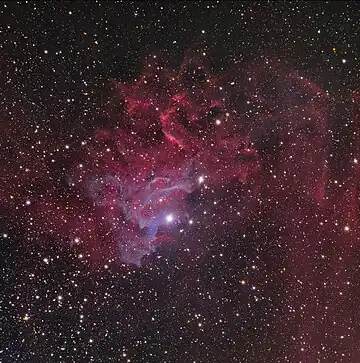
IC 405, also Sharpless 229 (Sh2-229), Caldwell 31 and The Flaming Star Nebula, is an emission/reflection nebula and a Caldwell object in the constellation Auriga, surrounding the bluish star AE Aurigae. It shines at magnitude +6.0. The nebula is about 5 light-years across. This is a white light image of the Flaming Star Nebula showing the "smoke" of reflection nebula.
Picture 4
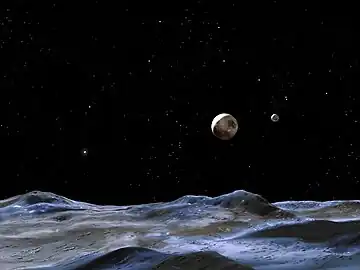
The five Moons of Pluto include Pluto's small satellite Hydra. Image is an artist's concept of the surface of Pluto, Hydra (center), Charon (right) and Nix (bright dot on left).
Picture 5
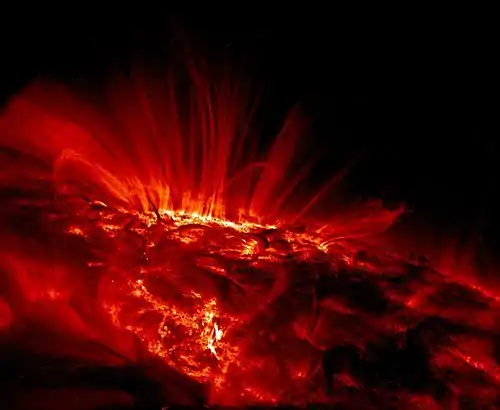
Sunspots are temporary phenomena on the surface of the Sun (the photosphere) that appear visibly as dark spots compared to surrounding regions. They are caused by intense magnetic activity, which inhibits convection, forming areas of reduced surface temperature. Although they are at temperatures of roughly 3,000–4,500 K (4,940–7,640 °F), the contrast with the surrounding material at about 5,780 K leaves them clearly visible as dark spots, as the intensity of a heated black body (closely approximated by the photosphere) is a function of T (temperature) to the fourth power.
Picture 6

Cassiopeia A (Cas A) is a supernova remnant in the constellation Cassiopeia and the brightest extrasolar radio source in the sky at frequencies above 1 GHz. The supernova occurred approximately 11,000 light-years (3.4 kpc) away in the Milky Way.
Picture 7

Orion's Belt or The Belt of Orion is an asterism in the constellation Orion. It consists of the three bright stars Alnitak, Alnilam, and Mintaka. The color picture was composited from photographic plates taken using the Samuel Oschin telescope at Palomar Observatory between 1987 and 1991.
Picture 8
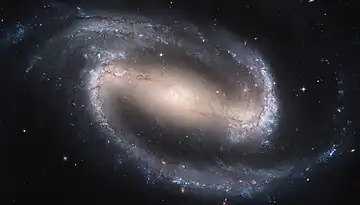
NGC 1300 is a barred spiral galaxy about 61 million light-years away in the constellation Eridanus. The galaxy is about 110,000 light-years across; just slightly larger than our own galaxy, the Milky Way.
Picture 9

In astronomy, the Pleiades, or Seven Sisters (Messier object 45), is an open star cluster containing middle-aged hot B-type stars located in the constellation of Taurus. It is among the nearest star clusters to Earth and is the cluster most obvious to the naked eye in the night sky.
Picture 10

NGC 4565 (also known as the Needle Galaxy or Caldwell 38) is an edge-on spiral galaxy about 30 to 50 million light-years away in the constellation Coma Berenices. The 10th magnitude galaxy sits perpendicular to our own Milky Way galaxy and is almost directly above the North Galactic Pole. First spotted in 1785 by Sir William Herschel (1738–1822), this is one of the most famous examples of an edge-on spiral galaxy.
Picture 11

The stellar nursery LH 95, in the Large Magellanic Cloud. The Initial Mass Function of LH 95 does not seem to differ from that typical for the Milky Way galaxy. Image of the Large Magellanic Cloud, a dwarf galaxy. At a distance of 163,000 light-years, it is the third closest galaxy to the Milky Way.
Picture 12
.png.webp)
The Hubble eXtreme Deep Field (HXDF), released on September 25, 2012, is an image of a portion of space in the center of the Hubble Ultra-Deep Field image. It covers an area of 2.3 arcminutes by 2 arcminutes, or approximately 80% of the area of the HUDF. The HXDF contains approximately 5,500 galaxies, the oldest of which are seen as they were 13.2 billion years ago.
Picture 13
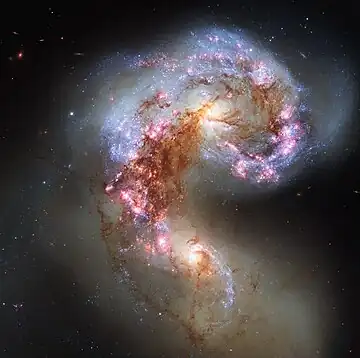
Antennae Galaxies (also known as NGC 4038/NGC 4039 or Caldwell 60/Caldwell 61) are a pair of interacting galaxies in the constellation Corvus. The Hubble Space Telescope image of NGC 4038 (top) and NGC 4039 (bottom) undergoing a galactic collision.
Picture 14

Hubble Space Telescope image of NGC 6052, discovered on 11 June 1784 by William Herschel. The two components of NGC 6052 are designated NGC 6052A and NGC 6052B are attracted by each other's gravity, have collided and are interacting with each other.
Picture 15
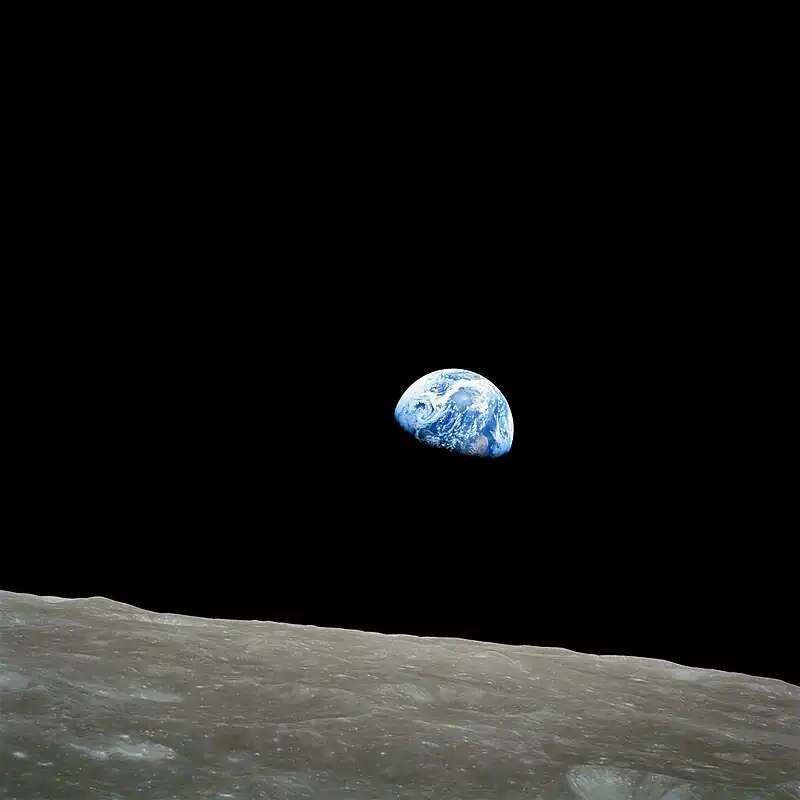
Earthrise is a photograph of Earth and some of the Moon's surface that was taken from lunar orbit by astronaut William Anders on December 24, 1968, during the Apollo 8 mission.
Picture 16
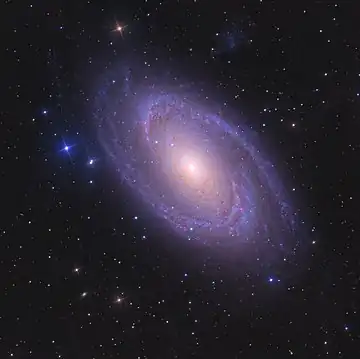
M81 with satellite galaxy Holmberg IX in the top center-right corner. Messier 81 is the largest galaxy in the M81 Group, a group of 34 in the constellation Ursa Major. Only one supernova has been detected in Messier 81.
Picture 17

Abell 2199 is a galaxy cluster in the Abell catalogue featuring a brightest cluster galaxy NGC 6166, a cD galaxy. Abell 2199, located in the Hercules constellation, is the definition of a Bautz-Morgan type I cluster due to NGC 6166.
Picture 18

A total solar eclipse during totality, seen from outside Crowheart, Wyoming on 21 August, 2017. At this point during the solar eclipse, the photograph shows both the Sun's corona and the surface features of the new moon itself, illuminated by earthshine.
Picture 19
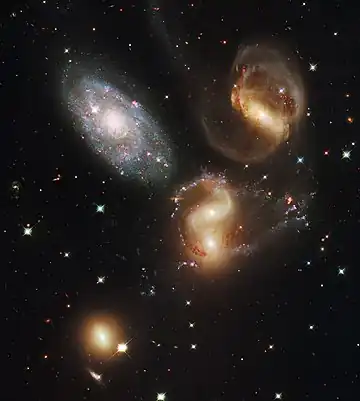
Stephan's Quintet is a visual grouping of five galaxies of which four form the first compact galaxy group ever discovered. The group, visible in the constellation Pegasus, was discovered by Édouard Stephan in 1877 at the Marseille Observatory.
Picture 20
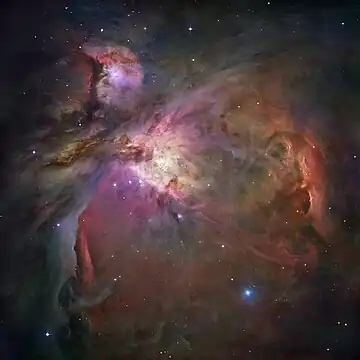
The Orion Nebula (also known as Messier 42, M42, or NGC 1976) is a diffuse nebula situated in the Milky Way, being south of Orion's Belt in the constellation of Orion. It is one of the brightest nebulae, visible to the naked eye in the night sky. The entire Orion Nebula in a composite image of visible light and infrared; taken by Hubble Space Telescope in 2006
Picture 21
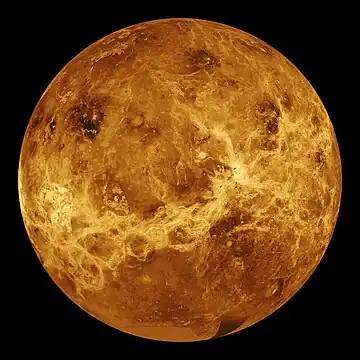
Geodynamics of Venus as seen from a global radar view of the surface from Magellan probe radar imaging between 1990 and 1994. The age of Venus was revealed by the observation of over 900 impact craters on the surface of the planet.
Picture 22
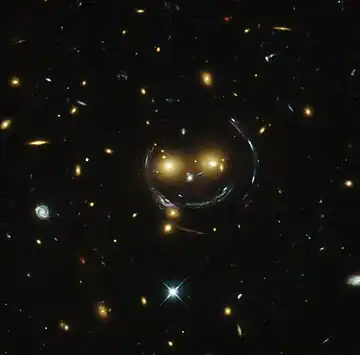
An Einstein ring is created when light from a galaxy or star passes by a massive object en route to the Earth. "Smiley" image of galaxy cluster (SDSS J1038+4849) & gravitational lensing (an Einstein ring) (HST).
Picture 23

PSR B1509−58 is a pulsar approximately 17,000 light-years away in the constellation of Circinus discovered by the Einstein X-Ray Observatory in 1982. X-rays from Chandra are gold; infrared from WISE in red, green and blue/max.
Picture 24

A neutron star is the collapsed core of a massive supergiant star, which had a total mass of between 10 and 25 solar masses, possibly more if the star was especially metal-rich. Image of the central neutron star at the heart of the Crab Nebula.
Picture 25

Coronal loops are huge loops of magnetic field beginning and ending on the Sun's visible surface (photosphere) projecting into the solar atmosphere (corona). Image of typical coronal loops observed by TRACE.
Picture 26
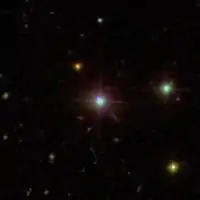
A quasar is an extremely luminous active galactic nucleus (AGN), in which a supermassive black hole with mass ranging from millions to billions of times the mass of the Sun is surrounded by a gaseous accretion disk. Sloan Digital Sky Survey image of quasar 3C 273, illustrating the object's star-like appearance. The quasar's jet can be seen extending downward and to the right from the quasar.
Picture 27

A galaxy cluster, or cluster of galaxies, is a structure that consists of anywhere from hundreds to thousands of galaxies that are bound together by gravity with typical masses ranging from 1014–1015 solar masses. MS 0735.6+7421 is a galaxy cluster located in the constellation Camelopardalis, approximately 2.6 billion light-years away. A composite image from Hubble and Chandra.
Picture 28

Alouette 1 is a deactivated Canadian satellite that studied the ionosphere. Launched in 1962, it was Canada's first satellite, and the first satellite constructed by a country other than the Soviet Union or the United States.
Picture 29
.png.webp)
Luminous blue variables (LBVs) are massive evolved stars that show unpredictable and sometimes dramatic variations in both their spectra and brightness. Luminous blue variable AG Carinae in the constellation Carina as seen by the Hubble Space Telescope.
Picture 30
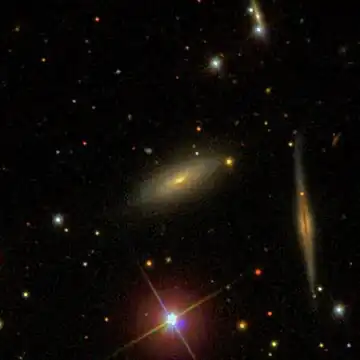
NGC 27 is a spiral galaxy located in the constellation Andromeda. It was discovered on 3 August 1884 by Lewis Swift.
Picture 31

NGC 7662 (also known as the Blue Snowball Nebula, Snowball Nebula, and Caldwell 22) is a planetary nebula located in the constellation Andromeda.
Picture 32
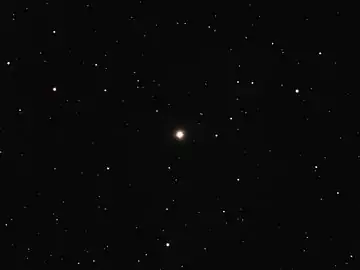
39 Arietis is a star in the northern constellation of Aries visible to the naked eye. This star was described as Lilii Borea by Nicolas-Louis de Lacaille in 1757.
Picture 33

Cosmic dust, also called extraterrestrial dust or space dust, is dust which exists in outer space, or has fallen on Earth. Image of a porous chondrite interplanetary dust particle.
Picture 34

Hygiea (minor planet designation: 10 Hygiea) is a major asteroid located in the main asteroid belt. It is the fourth-largest asteroid in the Solar System by both volume and mass.
Picture 35
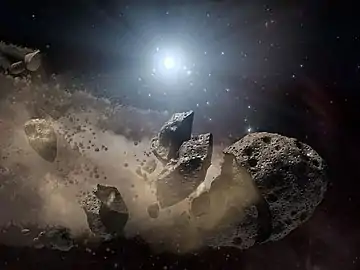
WD 0145+234 is a white dwarf star approximately 95 ly (29 pc) from Earth in the constellation of Aries that has been associated with studies suggesting that a very large exoasteroid near the star was substantially disrupted, resulting in a considerable amount of dust and debris around the star. It was discovered in 2019.
Picture 36

The Great Comet of 1882 formally designated C/1882 R1, 1882 II, and 1882b, was a comet which became very bright in September 1882. It was a member of the Kreutz Sungrazers, a family of comets which pass within 1 R☉ of the Sun's photosphere at perihelion.
Picture 37
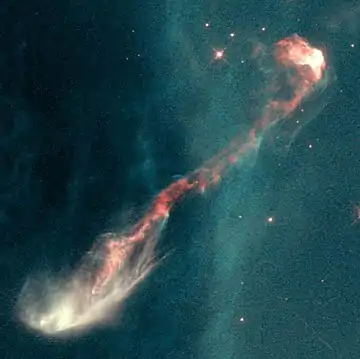
HH 46/47 is a complex of Herbig–Haro objects (HH objects), located around 450 parsecs (about 1,470 light-years) away in a Bok globule near the Gum nebula in the Vela constellation.
Picture 38

Active asteroids are small Solar System bodies that have asteroid-like orbits but show comet-like visual characteristics. Image of asteroid (596) Scheila displaying a comet-like appearance on December 12, 2010.
Picture 39
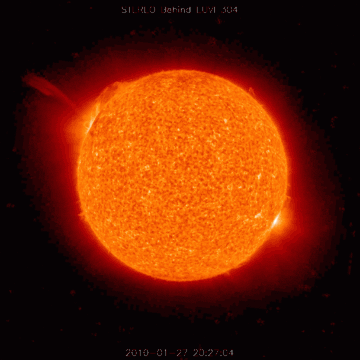
A coronal mass ejection (CME) is a significant release of plasma and accompanying magnetic field from the solar corona. They often follow solar flares and are normally present during a solar prominence eruption. Coronal mass ejections release large quantities of matter and electromagnetic radiation into space above the Sun's surface, either near the corona, or farther into the planetary system, or beyond (interplanetary CME).
Picture 40
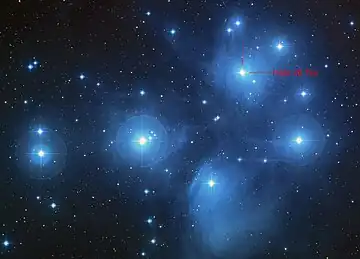
Maia is a star in the constellation of Taurus. It is a blue giant of spectral type B8 III, a chemically peculiar star, and the prototype of the Maia variable class of variable star. Image of Maia's location indicated in the upper right corner.
Picture 41

HD 28527 is a star in the constellation Taurus, and a member of the Hyades open cluster. It is faintly visible to the naked eye with an apparent visual magnitude of 4.78. The distance to this star, as determined from its parallax shift of 22 mas, is 148 light years.
Picture 42

Andromeda is one of the 48 constellations listed by the 2nd-century Greco-Roman astronomer Ptolemy, and one of the 88 modern constellations. Located north of the celestial equator, it is named for Andromeda, daughter of Cassiopeia. Andromeda is most prominent during autumn evenings in the Northern Hemisphere.
Picture 43
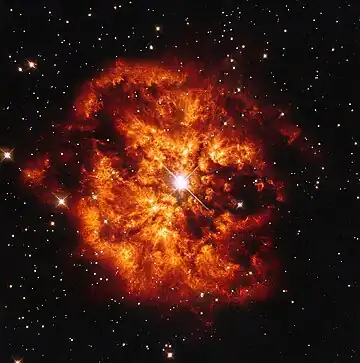
Wolf–Rayet stars, often abbreviated as WR stars, are a rare heterogeneous set of stars with unusual spectra showing prominent broad emission lines of ionised helium and highly ionised nitrogen or carbon. Hubble Space Telescope image of nebula M1-67 around Wolf–Rayet star WR 124.
Picture 44
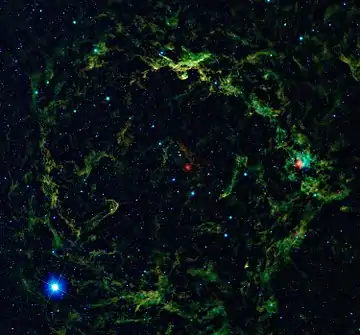
The Lambda Orionis Cluster (also known as the Collinder 69) is an open star cluster located north-west of the star Betelgeuse in the constellation of Orion. It is about five million years old and roughly 1,300 ly (400 pc) away from the Sun. Image is the Molecular Ring in infrared as seen by WISE.
Picture 45
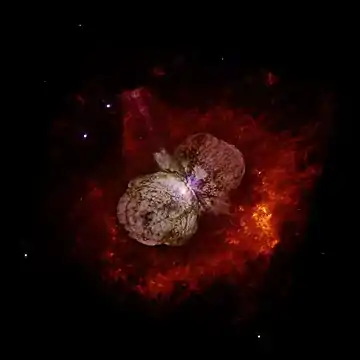
Gamma-ray burst progenitors are the types of celestial objects that can emit gamma-ray bursts (GRBs). GRBs show an extraordinary degree of diversity. They can last anywhere from a fraction of a second to many minutes. Image is Eta Carinae, in the constellation of Carina, one of the nearer candidates for a hypernova.
Picture 46
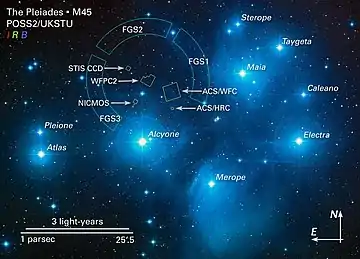
The Sterope or Asterope system is a double star in the zodiac constellation of Taurus. Image with indicated position of the Asterope pair in the Pleiades.
Picture 47
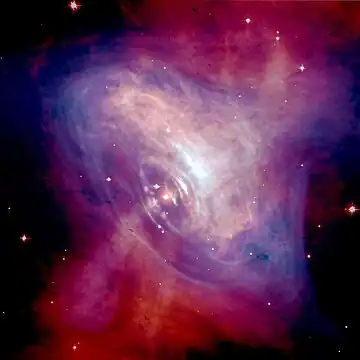
The Crab Pulsar (PSR B0531+21) is a relatively young neutron star. The star is the central star in the Crab Nebula, a remnant of the supernova SN 1054, which was widely observed on Earth in the year 1054.
Picture 48
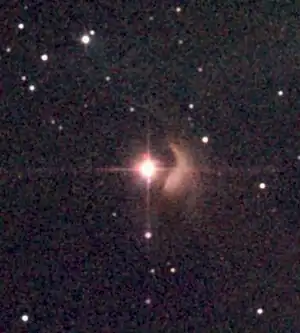
T Tauri is a variable star in the constellation Taurus, the prototype of the T Tauri stars. It was discovered in October 1852 by John Russell Hind.
Picture 49

GG Tauri, often abbreviated as GG Tau, is a quadruple or quintuple star system in the constellation Taurus at a distance of about 450 light years (140 parsecs) away. Image is an artist's impression of the disk surrounding GG Tauri A and B.
Picture 50
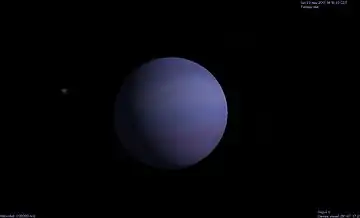
Pollux b is an extrasolar planet approximately 34 light-years away in the constellation of Gemini (the Twins). The planet has at least twice the mass of Jupiter.
Picture 51
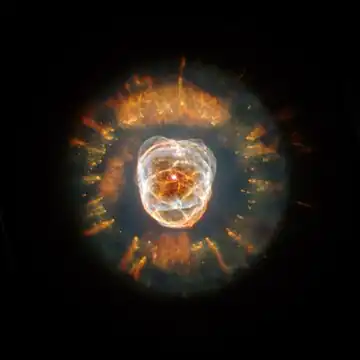
The Eskimo Nebula (NGC 2392), also known as the Clown-faced Nebula, Lion Nebula or Caldwell 39, is a bipolar planetary nebula (PN) discovered by astronomer William Herschel in 1787. Image of NGC 2392, the Eskimo Nebula is by HST in 1999.
Picture 52
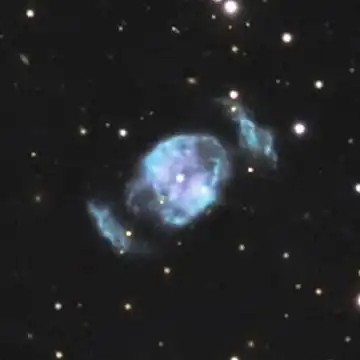
NGC 2371-2 is a dual lobed planetary nebula located in the constellation Gemini. At 13th magnitude, this nebula is well within the limits of most amateur telescopes.
Picture 53
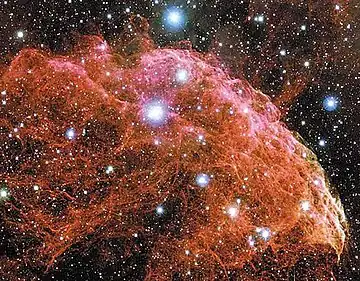
IC 443 (also known as the Jellyfish Nebula and Sharpless 248 (Sh2-248)) is a galactic supernova remnant (SNR) in the constellation Gemini. Its distance is roughly 5,000 light years from Earth. Image is part of the northeastern shell of IC 443, aka the Jellyfish Nebula.
Picture 54
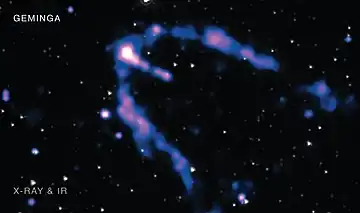
Geminga is a neutron star approximately 250 parsecs (around 800 light-years) from the Sun in the constellation Gemini. Geminga was the first example of an unidentified gamma-ray source. The Geminga image as seen by Chandra and Spitzer.
Picture 55
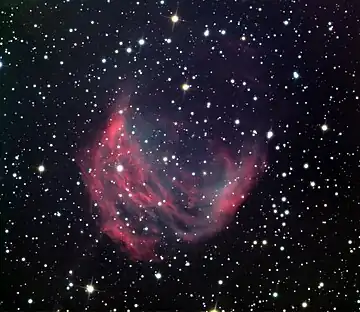
Medusa Nebula is a planetary nebula in the constellation of Gemini. It is also known as Abell 21 and Sharpless 2-274. It was originally discovered in 1955 by University of California, Los Angeles astronomer George O. Abell. Image of Medusa nebula from 24 inch telescope on Mt. Lemmon, AZ.
Picture 56

The International Space Station is photographed by an STS-134 crew member on the space shuttle Endeavour after the station and shuttle began their post-undocking relative separation. Undocking of the two spacecraft occurred on May 29, 2011.
Picture 57
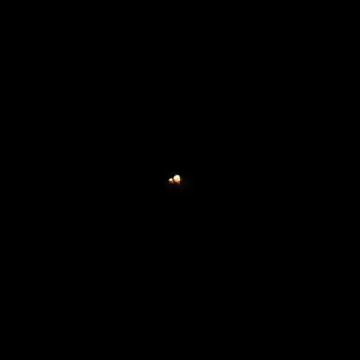
Alpha Herculis is a multiple star system in the constellation of Hercules. A view of Alpha Herculis in a small telescope. The components A and B are resolved with angular separation of 4.64'' (in 2020).
Picture 58

The 40-inch (1.02 m) refractor telescope backdrops Albert Einstein's visit to the Yerkes Observatory in May 1921. The 40-inch refractor telescope was modernized in the late 1960s with electronics of the period.
Picture 59
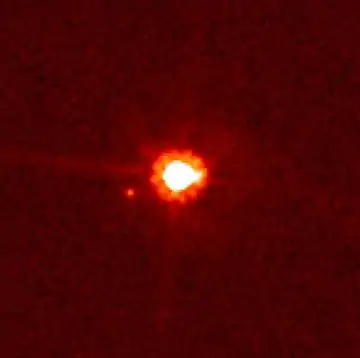
Eris (minor planet designation 136199 Eris) is the most massive and second-largest known dwarf planet in the Solar System. Image of Eris (center) and Dysnomia (left of center), taken by the Hubble Space Telescope
Picture 60
_3.jpg.webp)
A Dobsonian telescope is an altazimuth-mounted Newtonian telescope design popularized by John Dobson in 1965 and credited with vastly increasing the size of telescopes available to amateur astronomers. Photo of home made dobsonian used to make a solar projection (Split, Croatia).
Picture 61
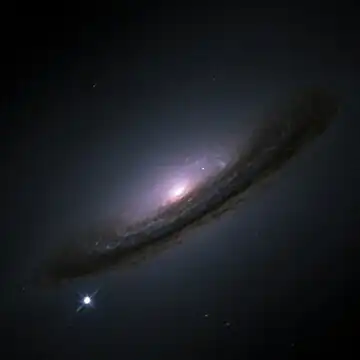
NGC 4526 (also listed as NGC 4560) is a lenticular galaxy located approximately 55 million light-years from the Solar System in the Virgo constellation and discovered on 13 April 1784 by William Herschel. Image of Supernova SN 1994D (lower left) in the outskirts of NGC 4526.
Picture 62
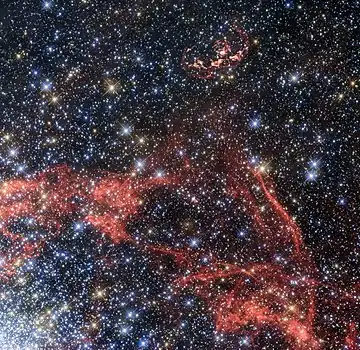
A type Ia supernova (read: "type one-A") is a type of supernova that occurs in binary systems (two stars orbiting one another) in which one of the stars is a white dwarf. The other star can be anything from a giant star to an even smaller white dwarf. Image is Supernova remnant N103B taken by the Hubble Space Telescope.
Picture 63
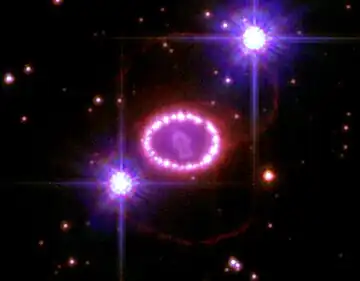
A Type II supernova (plural: supernovae or supernovas) results from the rapid collapse and violent explosion of a massive star. Image is the expanding remnant of SN 1987A, a Type II-P supernova in the Large Magellanic Cloud.
Picture 64
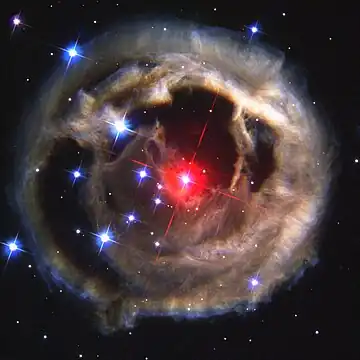
V838 Monocerotis (Nova Monocerotis 2002) is a spectroscopic binary star system in the constellation Monoceros about 19,000 light years (6 kpc) from the Sun. Image of V838 Monocerotis and its light echo from the Hubble Space Telescope on December 17, 2002.
Picture 65
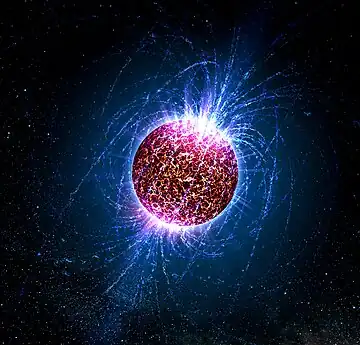
A radio-quiet neutron star is a neutron star that does not seem to emit radio emissions, but is still visible to Earth through electromagnetic radiation at other parts of the spectrum, particularly X-rays and gamma rays. Artist's illustration of an 'isolated neutron star' -- one without associated supernova remnants or binary companions.
Picture 66

The Beehive Cluster (also known as Praesepe (Latin for "manger"), M44, NGC 2632, or Cr 189), is an open cluster in the constellation Cancer and one of the nearest open clusters to Earth. Under dark skies, the Beehive Cluster looks like a small nebulous object to the naked eye, and has been known since ancient times.
Picture 67

SS 433 is an eclipsing X-ray binary system, with the primary most likely a black hole, or possibly a neutron star. Image is an artist's impression of SS 433.
Picture 68
.jpg.webp)
Messier 67 (also known as M67 or NGC 2682) is an open cluster in the southern, equatorial half of Cancer. It was discovered by Johann Gottfried Koehler in 1779. Image of Messier 67 (SDSS, optical and near-infrared).
Picture 69

The Musket Ball Cluster (DLSCL J0916.2+2951) is a galaxy cluster that exhibits separation between its baryonic matter and dark matter components. The cluster is a recent merger of two galaxy clusters in Cancer constellation. This composite image shows the Chandra (red) and Hubble (yellow and white) observation data.